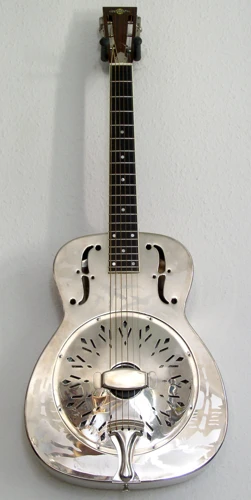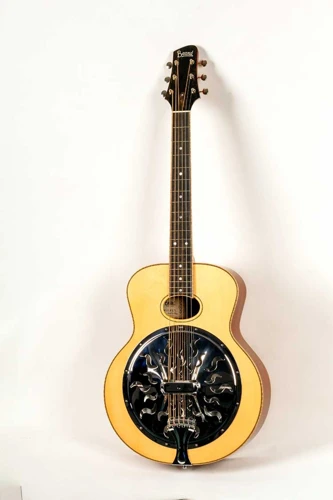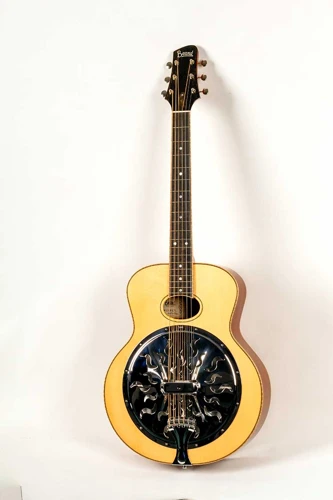The Emergence of the Acoustic Resonator Guitar
The acoustic resonator guitar, also known as the Dobro, has a distinctive metallic sound that sets it apart from other guitars. It emerged onto the scene in the 1920s, created by the Dopyera brothers who were looking for a way to create a guitar that could be heard above the sound of a big band.
The Dobro was designed with three aluminum resonator cones, which gave it a unique sound that was louder and more distinct than traditional acoustic guitars. It was initially marketed for Hawaiian music, but its versatility and unique sound soon caught the attention of American country music artists.
The Dobro quickly became a popular instrument among country musicians, as it provided a range of new sounds and tones that were previously unavailable. Its popularity flourished in the late 1920s and early 1930s, when it was embraced by early country music performers like Jimmie Rodgers and the Carter Family.
One of the key features that made the Dobro popular was its ability to be played loudly without being amplified. At the time, there were no electric amplifiers available, so the Dobro’s loud sound made it ideal for playing in large venues and recording studios.
The emergence of the acoustic resonator guitar played a significant role in the development of country music. It offered a range of new sounds and tones that were not available with traditional acoustic guitars. Its unique sound helped shape the genre and influenced how country music was played and recorded.
The emergence of the acoustic resonator guitar or Dobro in the 1920s, with its unique metallic sound, played a significant role in the evolution of American country music. Its distinctive tone and loud sound helped it gain popularity among early country music artists, and it continues to be a popular instrument today. The Dobro changed the game for acoustic guitar players and is a testament to the innovative spirit of the Dopyera brothers.
The Impact on Early Country Music
The early days of country music were defined by the raw, emotive sounds of acoustic guitars. However, with the emergence of the acoustic resonator guitar, the genre was forever changed. The instrument’s unique sound and construction had a profound impact, shaping the way early country musicians approached their craft. In this section, we’ll explore the impact of the acoustic resonator guitar on early country music, and how it helped pave the way for a new era of sound. To learn more about the role of other guitar-related instruments and components in country music, check out our articles on acoustic guitar body styles, country guitar makers, gut-to-steel guitar strings, dreadnought guitars, and pickup acoustic guitars.
Blues and Hillbilly Music
Before the emergence of the acoustic resonator guitar, early country music was heavily influenced by the blues and hillbilly music. The introduction of this new instrument opened up a world of possibilities for these genres.
Blues Music
The blues originated in the African American communities in the Deep South and heavily influenced country music. The introduction of the resonator guitar added a new layer of sound to the blues, amplifying the instrument’s volume and projection. This allowed for a greater range of expression, from deep and soulful to bright and lively. Artists like Robert Johnson and Blind Willie Johnson were pioneers in using the resonator guitar and became some of the most influential blues musicians in history.
Hillbilly Music
Hillbilly music, later known as country music, began in the rural communities of the American South. The acoustic resonator guitar quickly became a staple instrument in these communities, with its twangy and bright sound perfectly complementing the genre’s folk roots. The instrument was especially popular among musicians who played in string bands, which were prevalent in the early days of country music. The electric guitar hadn’t been invented yet, so the resonator guitar was a crucial instrument to help these musicians stand out on stage and in recordings.
While the resonator guitar was predominantly used in blues and hillbilly music during its early days, it quickly became a versatile instrument that could be used in a variety of genres. In fact, it played a large role in the birth of the country genre, which would go on to become one of the most popular forms of music in America.
If you want to learn more about the role of the acoustic guitar in the birth of the country genre, check out our article “The Role of the Acoustic Guitar in the Birth of the Country Genre“.
The Rise of Bluegrass
During the 1940s and 1950s, the acoustic resonator guitar became an essential component of bluegrass music, a genre that emerged from the Appalachian region of the United States. The distinct sound of the resonator guitar helped shape the music and contributed to the genre’s popularity. Here are some key factors that led to the rise of bluegrass and its association with the resonator guitar:
- Traditional instrumentation: Bluegrass is often characterized by its use of traditional acoustic instruments such as the banjo, fiddle, mandolin, upright bass, and of course, the resonator guitar. These instruments were originally used to play traditional Appalachian folk music and were blended together to create a unique, fast-paced sound that came to be known as bluegrass.
- Bill Monroe: Known as the “Father of Bluegrass Music,” Bill Monroe was an American mandolinist, singer, and songwriter who played a critical role in popularizing the genre. Monroe and his band, the Blue Grass Boys, were one of the first groups to incorporate the resonator guitar into their music. The use of the instrument added a new dimension to their sound and helped to establish the resonator guitar as a staple in bluegrass music.
- Flatpicking: Flatpicking is a guitar playing technique where the strings are picked using a flat pick rather than a fingerstyle approach. It became popular in bluegrass music and was often used in conjunction with the resonator guitar. The combination of flatpicking and the resonator guitar’s unique sound helped to create a distinct and powerful sound that became synonymous with bluegrass music.
- Popularity of the Grand Ole Opry: The Grand Ole Opry is a weekly country music stage concert in Nashville, Tennessee. It played a significant role in popularizing bluegrass music and introducing it to a broader audience. Many bluegrass artists, including those who played the resonator guitar, performed at the Opry and gained a following among country music fans.
With the emergence of bluegrass music, the resonator guitar became even more important in American country music. Its unique sound and versatility made it a popular instrument among country musicians of all backgrounds. In the modern era of country music, the resonator guitar continues to be a significant instrument, and its legacy in bluegrass music will always be remembered.
Modern Country and the Resonator Guitar
As the years went by, the acoustic resonator guitar continued to evolve and find its place in modern country music. Despite the advent of electric guitars and other instruments, the resonator guitar managed to hold its ground and remains a beloved instrument among musicians and fans alike. Let’s explore how this unique guitar has shaped the sound of modern country music and why it continues to be a cherished part of this genre’s history.
The Instrument’s Continued Popularity
As we move into modern country music, we see that the acoustic resonator guitar still maintains its popularity. It’s not hard to see why, as this unique instrument has a sound that cannot be replicated by any other guitar.
One reason for the continued popularity of the resonator guitar is its distinct sound. The metal resonator cones amplify the sound of each string, giving it a loud, piercing tone that can cut through any mix. Because of this unique sound, many contemporary country musicians use resonator guitars as their primary instrument or as a secondary instrument to add texture and dimension to their music.
Another reason for the instrument’s popularity is its adaptability. While the resonator guitar is often associated with traditional country and bluegrass music, it can be used in a variety of genres. From rock to folk to blues, the resonator guitar adds a unique flair to any musical style.
Some notable contemporary country musicians who regularly use resonator guitars include Chris Stapleton, Jerry Douglas, and Vince Gill. These musicians have incorporated the instrument into their music in various ways, creating their unique sound and style.
Table: Notable Contemporary Country Musicians Who Use Resonator Guitars
| Musician | Style | Notable Song |
|---|---|---|
| Chris Stapleton | Country Rock, Blues | Tennessee Whiskey |
| Jerry Douglas | Bluegrass, Roots Music | The Boxer |
| Vince Gill | Contemporary Country | What You Give Away |
The continued popularity of the acoustic resonator guitar in country music is a testament to the instrument’s unique sound and adaptability. As long as country music continues to evolve and musicians seek to create new sounds and styles, we can expect the resonator guitar to play an important role in the genre.
Notable Artists Who Use Resonator Guitars
The acoustic resonator guitar has been a staple of country music for decades, and many notable artists have utilized its unique sound to add depth and complexity to their music. Let’s take a look at some of the most prominent names in country music who have mastered the art of playing this remarkable instrument:
| Tony Rice | A true virtuoso on the acoustic resonator guitar, Tony Rice is widely considered to be one of the greatest pickers of all time. His unique blend of flatpicking and fingerstyle playing has influenced countless musicians over the years, and his use of the resonator guitar has helped to define the sound of modern bluegrass music. |
| Jerry Douglas | Another master of the resonator guitar, Jerry Douglas has won numerous Grammy awards for his innovative playing style. His ability to seamlessly blend elements of blues, jazz, and country music has made him one of the most respected musicians in the industry, and his use of the resonator guitar has helped to popularize the instrument among a wider audience. |
| Alison Krauss | As one of the most successful female singers in the country music industry, Alison Krauss has earned numerous accolades for her soulful voice and masterful fiddle playing. She is also an accomplished player on the resonator guitar, and her use of the instrument has helped to bring its unique sound to a wider audience. |
| Josh Graves | Considered by many to be the father of modern resonator guitar playing, Josh Graves was a true pioneer in the industry. His unique blend of flatpicking and fingerstyle playing helped to define the sound of early bluegrass music, and his influence can be heard in the playing style of countless modern musicians. |
| Dobro Joe | A relative newcomer to the country music scene, Dobro Joe has quickly made a name for himself as one of the most exciting new players on the resonator guitar. His innovative use of the instrument has earned him critical acclaim from fans and industry insiders alike, and his star is sure to continue to rise in the years ahead. |
As these examples demonstrate, the resonator guitar has played a crucial role in the development of country music over the years. From its early beginnings in blues and hillbilly music to its modern use in contemporary country music, this unique instrument has helped to shape and define the sound of the genre for generations to come.
The Future of the Acoustic Resonator Guitar in Country Music
As the world of music continues to evolve, it’s fascinating to consider what the future holds for the acoustic resonator guitar in country music. While some might argue that the instrument’s heyday has long since passed, others contend that it’s only a matter of time before a new generation of performers picks up the resonator guitar and takes it in exciting new directions.
One important factor in the future of the resonator guitar is the ongoing development and refinement of the instrument itself. With today’s advanced technology, it’s now possible to create resonator guitars that boast unparalleled sound quality, durability, and playability.
The resonator guitar’s unique tone and versatility make it an ideal instrument for experimentation and innovation. Whether played in the traditional bluegrass style or incorporated into more modern country arrangements, the resonator guitar has a sound that can make any song feel fresh and vibrant.
Another key factor in the future of the resonator guitar in country music is the growing appreciation for classic and vintage instruments. As more musicians seek out unique and interesting guitars to add to their collections, there’s no doubt that the resonator guitar will continue to enjoy a dedicated following.
At the same time, younger musicians are becoming increasingly interested in the history and legacy of the resonator guitar, and are eager to explore its rich sound and musical possibilities. With its distinctive voice, the resonator guitar is sure to continue inspiring new generations of country artists for years to come.
The future of the acoustic resonator guitar in country music is bright and full of potential. Whether playing traditional bluegrass tunes or experimenting with new sounds, the resonator guitar remains a vital and exciting part of the country music landscape. With its unique tone and deep musical history, the resonator guitar is sure to remain a beloved instrument for many years to come.
Conclusion
After examining the history and evolution of the acoustic resonator guitar, it is clear that this instrument has had a profound impact on the development of American country music. From its origins as a tool for amplifying sound in the early 20th century to its prominent use by legends like Roy Acuff and Earl Scruggs, the resonator guitar has become an indelible part of the country music landscape.
Even as country music has evolved over time, with new subgenres emerging and chart-topping artists experimenting with new sounds and instrumentation, the resonator guitar has held its own. Its unique metallic sound, created by the spinning metal cones inside the guitar’s body, has been utilized by a wide range of artists across the country spectrum, from traditionalists like Brad Paisley and Alison Krauss to more experimental acts like Mumford & Sons and The Avett Brothers.
Looking to the future, it seems likely that the acoustic resonator guitar will continue to play an important role in country music. As new artists emerge and the genre continues to evolve, the resonator guitar’s versatility and distinctive sound will undoubtedly continue to make it a go-to choice for musicians looking to add a unique element to their music.
In conclusion, the acoustic resonator guitar has left an indelible mark on American country music, influencing its development and earning a place as one of its most iconic instruments. Its continued popularity and versatility ensures that it will remain a fixture of the country music landscape for years to come.
Frequently Asked Questions
1. What is an acoustic resonator guitar?
An acoustic resonator guitar is a type of guitar which produces sound by way of a metal resonator cone instead of a traditional soundboard.
2. When was the acoustic resonator guitar first invented?
The first acoustic resonator guitar was invented in the 1920s by John Dopyera and his brothers.
3. How does the acoustic resonator guitar produce sound?
The metal resonator cone inside the guitar vibrates, producing a distinct tone which is amplified and projected through the guitar’s body.
4. What styles of music commonly feature the acoustic resonator guitar?
The acoustic resonator guitar is heavily featured in early country, blues, and bluegrass music.
5. Why was the acoustic resonator guitar popular in early country music?
The acoustic resonator guitar’s loud and distinct sound made it ideal for the rural radio broadcasts of the 1920s and 30s, where performers needed an instrument that could stand out from other instrumentation and noisy environments.
6. Who are some notable artists that use the acoustic resonator guitar?
Notable artists who use the acoustic resonator guitar include Jerry Douglas, Tony Furtado, and Ry Cooder among many others.
7. Can the acoustic resonator guitar be used for genres other than country and blues?
While the acoustic resonator guitar has primarily been associated with early country and blues, it has been adopted by many modern musicians across a variety of genres such as folk, indie, and even heavy metal.
8. How has technology impacted the acoustic resonator guitar?
Modern manufacturing techniques have made acoustic resonator guitars more accessible and affordable, while advancements in amplification technology have made it easier for performers to achieve the signature sound of the acoustic resonator guitar on stage.
9. Is the acoustic resonator guitar difficult to play?
Like any instrument, it takes time and practice to become proficient on the acoustic resonator guitar. However, its large and wide neck can pose a challenge for some players.
10. Can you play different styles on an acoustic resonator guitar?
Yes, with its versatility and unique sound, the acoustic resonator guitar can be played in various styles such as fingerstyle, slide, and even flatpicking.



